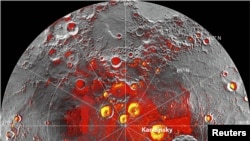Scientists said the planet closest to the Sun might harbor water ice in pockets that are perpetually hidden from the blazing heat and light.
NASA's MESSENGER spacecraft is orbiting the planet Mercury, and researchers involved with the mission said it has provided more support for scientists' beliefs that the planet has water ice in many of the dark craters at its poles. They said the MESSENGER spacecraft has yielded measurements of excess hydrogen and reflectance, as well as information that has helped them understand temperatures of Mercury's north polar regions.
The scientists described their findings at a news briefing at NASA headquarters in Washington Thursday.
Researchers previously had identified what they believed to be patches of frozen water in shaded areas near the poles. Just like ice, the areas reflect radar, so they appear as bright spots.
NASA's MESSENGER craft has been studying Mercury since it arrived at the planet last year.
The MESSENGER probe's name is an acronym for its multi-faceted mission: "ME" for Mercury, "SS" for surface and space, "EN" for environment, "GE" for geochemistry, and "R" for ranging. MESSENGER was launched in 2004, and it took seven years for the craft to reach Mercury.
Researchers say MESSENGER'S observations will help them better understand how Mercury and other planets in the solar system formed some 4.5 billion years ago.
The new findings are detailed in three papers published online in Science Express.
NASA's MESSENGER spacecraft is orbiting the planet Mercury, and researchers involved with the mission said it has provided more support for scientists' beliefs that the planet has water ice in many of the dark craters at its poles. They said the MESSENGER spacecraft has yielded measurements of excess hydrogen and reflectance, as well as information that has helped them understand temperatures of Mercury's north polar regions.
The scientists described their findings at a news briefing at NASA headquarters in Washington Thursday.
Researchers previously had identified what they believed to be patches of frozen water in shaded areas near the poles. Just like ice, the areas reflect radar, so they appear as bright spots.
NASA's MESSENGER craft has been studying Mercury since it arrived at the planet last year.
The MESSENGER probe's name is an acronym for its multi-faceted mission: "ME" for Mercury, "SS" for surface and space, "EN" for environment, "GE" for geochemistry, and "R" for ranging. MESSENGER was launched in 2004, and it took seven years for the craft to reach Mercury.
Researchers say MESSENGER'S observations will help them better understand how Mercury and other planets in the solar system formed some 4.5 billion years ago.
The new findings are detailed in three papers published online in Science Express.
